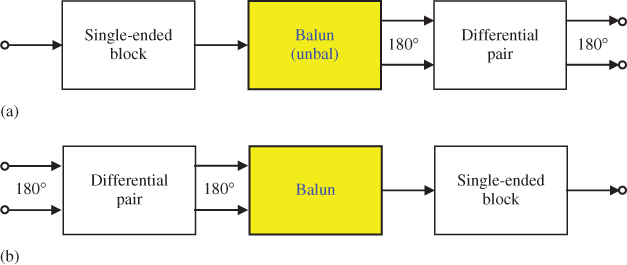Chapter 15
RF Balun
15.1 Introduction
A balun is a transformation block between a single-ended stage and a differential pair.
A balun transforming a signal from a single-ended stage to a differential pair splits a single-ended signal into a pair of differential signals with the same magnitude but 180° phase difference. It is called splitter as shown in Figure 15.1(a). A differential pair plays some special functions in the transport or manipulation of a signal. For instance, the capability of common mode rejection potentially exists in a differential pair but not in a single-ended stage.
Figure 15.1 A balun, which is a block between a single-ended block and a differential pair. (a) From single-ended block to differential pair. (b) From differential pair to single-ended block.

A balun transforming a signal from a differential pair to a single-ended stage combines a pair of differential signals with the same magnitude but 180° phase difference as a single-ended signal. It is called combiner as shown in Figure 15.1(b). The conversion from a differential pair to a single-ended stage simplifies both simulation and testing of a block.
The word “balun” is a portmanteau formed from the words “balanced” and “unbalanced,” in which balanced implies a differential configuration and unbalanced represents a single-ended configuration. It would seem reasonable to rename the balun in Figure 15.1 ...
Get RF Circuit Design, 2nd Edition now with the O’Reilly learning platform.
O’Reilly members experience books, live events, courses curated by job role, and more from O’Reilly and nearly 200 top publishers.

